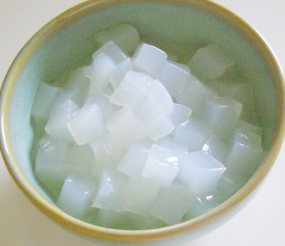Be Slim with Nata de Coco
Although originating from waste coconut, nata de coco be enough food ideal for those who are trying to lose weight. Therefore, food ingredients derived from coconut water, other than it tastes good and is suitable for many tongues, is also rich in fiber.
The term comes from the Spanish nata translated into Latin sebagainatare, meaning adrift. Nata can be made from coconut milk, coconut milk, molasses (molasses), wastewater know, or juice (pineapple, melon, passion fruit, banana, citrus, guava, strawberry, etc.).
Giving a name to nata depending on the raw materials used. Nata de pinna to that derived from pineapple, nata de tomato to tomato, and nata de soya made from waste out.
In recent nata industrial development, food is generally made from coconut milk. Nata with fruit flavors made from coconut milk, but the added flavor of the fruit. We too easily get the product nata with vanilla, strawberry, banana, citrus, guava, pineapple, and others.
Nata de coco is fermented coconut water with the help of microbe Acetobacter xylinum. Sugar in coconut water is converted to acetic acid and cellulose yarn. Will eventually form a solid mass and reaches a thickness of several centimeters.
Thus, nata de coco can also be regarded as a form of bacterial cellulose solid, white, transparent, sweet taste, chewy texture, and generally consumed as snacks.
Starter or microbial culture is a most important ingredient in the formation of nata. As a starter, used pure cultures of Acetobacter xylinum. These bacteria can be found naturally in sugar plant extracts that have undergone fermentation or on vegetables and fruits that have been rotting sugary.
If microbes are grown in medium containing glucose, the organism can change 19 percent sugar into cellulose. Cellulose issued to the media in the form of threads together with a slimy polysaccharide forming fabric continues to thicken into layers nata.
Suitable for Diet
Nata de coco attractiveness lies in the clear color, chewy texture, and the taste is very distinctive. Therefore, nata mixture in a range of cold drinks are very popular with the public. Especially in tropical regions, such as in the country.
The most popular use is as a dessert. Nata de coco can also be enjoyed as a mixture of iced fruit, compote, custard, ice cream, fruit cocktail, candy, or eaten away.
Seen from the point of nutrition, nata does not mean anything because the product is very poor in nutrients. Nata nutrient which was served with syrup was as follows: 67.7 percent water, 0.2 percent fat, 12 mg calcium, 5 mg iron, 2 mg phosphorus, few vitamins B1, a little protein, and only 0.01 micrograms of riboflavin per 100 grams.
Some actions fortification with vitamins (niacin, riboflavin, vitamin B1, and vitamin C) and minerals (calcium and phosphorus), has been done to improve its nutritional value. Supplemental materials are stable at room temperature for 11 months or more. To increase the acceptance of consumers, nata de coco is often coupled with flavor extracts or essences, such as almond, banana, orange, strawberry, vanilla, and others.
Because the nutrients (particularly energy) is very low, this product is safe to be eaten by anyone. This product will not cause fat, so it is recommended for those who are low-calorie diet to lose weight. Another advantage of nata de coco is a fiber (dietary fiber), it is quite high, especially cellulose.
Without fiber in the diet, we would easily have symptoms of constipation or constipation (constipation), hemorrhoids, diverticulosis disease, colon cancer, inflammation of the appendix, diabetes, coronary heart disease, and obesity (obesity). With the fiber of nata de coco or other foodstuffs, the bowel movements become regular and these diseases can be avoided.
Although nata de coco low nutritional content, eating the wrong way can cause us to be fat. The process of becoming obese is not caused by nata de coco itself. The cause is too sweet syrup or other mixing ingredients. Therefore, avoid eating nata de coco with a mixture that is too sweet syrup or other ingredients are rich in calories.
Nata de coco is usually sold in bottles, cans, or plastic bag with a solution of sugar as a medium marinade. The intended use of the sugar solution is to preserve nata de coco for storage.
If we want to take nata de coco, syrup should be shredded waste that we do not become too sweet nata. To further reduce the levels of sugar, nata de coco should first be soaked in water for a while before consumption. Sharing is sexy


 Previous Entries
Previous Entries



